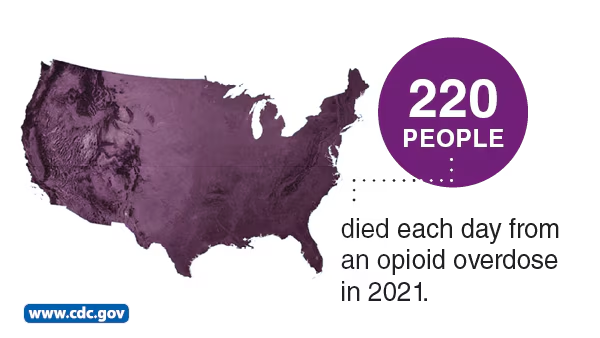WHAT TO KNOW
- The number of opioid-related deaths has been rising continuously since 1999.
- Three distinct waves of increases are related to different types of opioids throughout the last 25 years.
- Increasing communities’ support, capacity, and education may help turn the tide and prevent overdose deaths.
Opioid-related deaths are rising
Drug overdose deaths
- The number of people who died from a drug overdose in 2021 was over six times the number in 1999.
- The number of drug overdose deaths did not significantly change from 2021 to 2022.
- Over 75% of the nearly 107,000 drug overdose deaths in 2022 involved an opioid.
2021-2022
- Opioid-involved death rates decreased by 12.5%.
- Prescription opioid-involved death rates remained the same.
- Heroin-involved death rates decreased nearly 36%.
- Synthetic opioid-involved death rates (excluding methadone) increased over 4%.1
Three waves of opioid overdose deaths
From 1999-2021, nearly 645,000 people died from an overdose involving any opioid, including prescription and illicit opioids.
This rise in opioid overdose deaths can be outlined in three distinct waves.
First wave
The first wave began with increased prescribing of opioids in the 1990s, with overdose deaths involving prescription opioids (natural and semi-synthetic opioids and methadone) increasing since at least 1999.
Second wave
The second wave began in 2010, with rapid increases in overdose deaths involving heroin.
Third wave
The third wave began in 2013, with significant increases in overdose deaths involving synthetic opioids, particularly those involving illegally made fentanyl. The market for illegally made fentanyl continues to change, and it can be found in combination with heroin, counterfeit pills, and cocaine.
Many opioid-involved overdose deaths also include other drugs.
Confronting the opioid overdose epidemic
CDC is committed to fighting the opioid overdose epidemic and supporting states and communities as they continue work to identify outbreaks, collect data, respond to overdoses, and provide care to those in their communities.
What CDC’s work focuses on
- Monitoring trends to better understand and respond to the epidemic.
- Advancing research by collecting and analyzing data on opioid-related overdoses and improving data quality to better identify areas that need assistance and to evaluate prevention efforts.
- Building state, local and tribal capacity by equipping states with resources, improving data collection, and supporting use of evidence-based strategies. Overdose Data to Action (OD2A) is cooperative agreement provides funding to 90 health departments under two distinct OD2A programs to reduce drug overdoses and the impact of related harms.
- Supporting providers, healthcare systems, and payers with data, tools, and guidance for evidence-based decision-making to improve opioid prescribing and patient safety.
- Partnering with public safety officials and community organizations, including law enforcement, to address the growing illicit opioid problem.
- Increasing public awareness about prescription opioid misuse and overdose and to make safe choices about opioids.
Overdose Data to Action
Overdose Data to Action (OD2A) is a cooperative agreement that provides funding to 90 health departments under two distinct OD2A programs (State and Local) to reduce drug overdoses and the impact of related harms. This cooperative agreement supports jurisdictions in implementing prevention activities and in collecting accurate, comprehensive, and timely data on nonfatal and fatal overdoses and in using those data to enhance programmatic and surveillance efforts. OD2A focuses on understanding and tracking the complex and changing nature of the drug overdose crisis by seamlessly integrating data and prevention strategies.
Collaboration helps save lives
Collaboration is essential for success in preventing opioid overdose deaths. Medical personnel, emergency departments, first responders, public safety officials, mental health and substance use treatment providers, community-based organizations, public health, and members of the community all bring awareness, resources, and expertise to address this complex and fast-moving epidemic. Together, we can better coordinate efforts to prevent opioid overdoses and deaths.
Source: https://www.cdc.gov/overdose-prevention/about/understanding-the-opioid-overdose-epidemic.html



